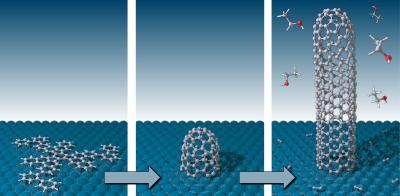
On a platinum surface, the planar hydrocarbon precursor folds into an end cap, that in turn acts as seed for the growth of a well-defined carbon nanotube. The image below shows scanning tunneling microscopy images of the precursor, the «folded» end cap, and the resulting carbon nanotube, together with the corresponding structural models. Credit: (Source: Empa / Juan Ramon Sanchez Valencia)
Physicists have successfully synthesized structurally uniform carbon nanotubes (SWCNTs) with clearly defined electronic properties.
Single-wall carbon nanotubes (SWCNTs) exhibit drastic changes in their electronic properties if their structure undergoes the slightest change. Therefore making structurally homogeneous SWCNTs is the subject of intense research.
A team of chemists and physicists from the Max Planck Institute and Empa has been exploring the mechanism of molecular transformation or integration for creating complex nanostructures on a surface for quite a while.
According to Roman Fasel, Head of the "nanotech@surfaces" Laboratory at Empa, finding the appropriate starting molecule is the real challenge in creating such complex nanostructures.
The Max Planck Institute team was able to develop the right candidate - a hydrocarbon with 150 atoms.
From this point the initially flat molecule must become a 3D ‘germling’. This is achieved via a catalytic reaction to form carbon to carbon bonds in specific areas.
Further carbon atoms are then added to grow the nanotube gradually upwards. The team were able to show that it is the germ alone that defines the atomic structure of the nanotube.
The researchers demonstrated that the growth as well as the structure of long SWCNTs can be predefined with the help of molecular "germs." The resulting SWCNTs are mirror-image symmetrical.
Further to this, materials that are not mirror-image symmetrical such as helically wound nanotubes can also be synthesized based on the mechanism involved in the formation of honeycombed atomic lattice from the starting molecule.
The material’s optical, electronic, and thermoelectric properties rely on this structure. Although more than 100 million nanotubes are grown per cm2 of the platinum surface, the growth of the actual "fully grown" nanotubes is only from a tiny proportion of the molecular germs.
The next step for the researchers will be to gain even more knowledge about the mechanism of growth of SWCNTs on a surface, and how the yield can be increased for real world applications.
Disclaimer: The views expressed here are those of the author expressed in their private capacity and do not necessarily represent the views of AZoM.com Limited T/A AZoNetwork the owner and operator of this website. This disclaimer forms part of the Terms and conditions of use of this website.